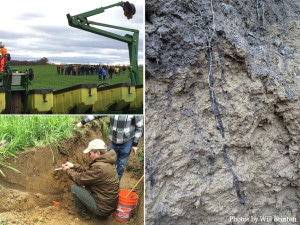
Farmers and crop consultants gather to hear about cover crops and soil health at Faihopity Farms Dairy (PA). Root-worm channels under cover-crops are examined by Jason Fellon, DEP Watershed Manager. The vertical channels extend downwards 28″ and may act as a water and nutrient transport system.
Soil Health aficionados like to say that roots and worms make channels down into the soil – transferring nutrients and carbon between soil layers. What this looks like in reality was made clear at a recent Soil Health field-day in Berwick, PA, sponsored by NRCS and the PA No-till Alliance, with crop consultant Gerard Troisi and soil tester Will Brinton from Woods End Lab, Maine. A soil pit dug in the triticale cover crop at the Broyan family’s Faihopity Farm showed a remarkable coincidence of worms and the roots: the earthworm channels extended down nearly 28″ and following them, a trail of roots and humus. “We can’t tell which happened first – if the roots were followed by the worms eating their way down, or the worms made channels that the roots took advantage of, but it belongs to a healthy state”, explained Will Brinton who presented Soil Health Tool test (SHT) results for the farm. Attendees at the event observed a significant quantity of earthworm castings on the soil surface in the triticale fields. Samples of soil taken under the triticale had Solvita respiration of 123 ppm CO2-C indicating an extremely vibrant biology in the topsoil profile. Recent published research in Applied Soil Ecology reported soil basal CO2 respiration around earthworm burrows to be twice that of surrounding soil. And, as the picture shows, those benefits are likely being transferred to deeper layers.
In 1881, Charles Darwin brought international recognition to the lowly earthworm by publishing detailed observations of earthworm habits in farm fields. Among his findings: worms are capable of moving and depositing as much as 15 tons of soil per acre/year as enriched castings on the soil surface. Earthworm awareness has increased significantly since his time, yet there is still under-appreciation of the quantitative role they play in soil building and just how much tillage may diminish their populations. Closer observation of the picture makes evident that the worm/root channels have made a very significant impact with obvious infractions nearly every 4″ laterally across the pit sidewall and extending downwards to depths greater than 24″.
The field in question is slated to be no-tilled corn for 2014. Soil health tool results from Woods End Laboratories suggested reducing N rates and no additional P or K required. Farmer Chris Broyan says he plans to follow these SHT recommendations to see how it turns out.
